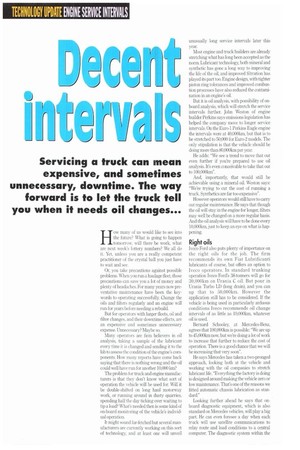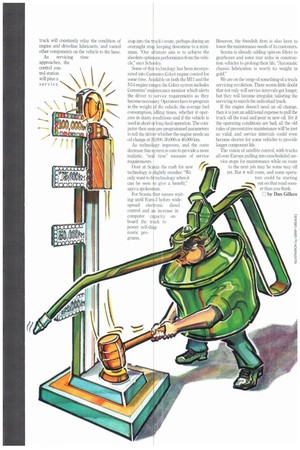Decent t
Page 64

Page 65

If you've noticed an error in this article please click here to report it so we can fix it.
How many of us would like to see into the future? What is going to happen tomorrow, will there be work, what are next week's lottery numbers? We all do it. Yet, unless you are a really competent practitioner of the crystal ball you just have La wait and see.
Or, you take precautions against possible problems. When you run a haulage fleet, those precautions can save you a lot of money arid plenty of headaches. For many years now preventative maintenance have been the keywords to operating successfully. Change the oils and filters regularly and an engine will run for years before needing a rebuild.
But for operators with larger fleets, oil and filter changes, and their downtime effects, are an expensive and sometimes unnecessary expense. Unnecessary? Maybe so.
Many operators are firm believers in oil analysis, taking a sample of the lubricant every time it is changed and sending it to the lab to assess the condition of the engine's components. How many reports have come back saying that there is nothing wrong and the oil could well have run for another 10,000 km?
The problem for truck and engine manufacturers is that they don't know what sort of operation the vehicle will be used for. Will it be double-shifted on long haul motorway work, or running around in dusty quarries, spending half the day ticking over waiting to tip a load? What's needed then is some kind of on-board monitoring of the vehicle's individual operation.
It might sound far-fetched but several manufacturers are currently working on this sort of technology, and at least one will unveil unusually long service intervals later this year.
Most engine and truck builders are already stretching what has long been accepted as the norm. Lubricant technology, both mineral and synthetic has gone a long way to improving the life of the oil, and improved filtration has played its part too. Engine design, with tighter piston ring tolerances and improved combustion processes have also reduced the contamination in an engine's oil.
But it is oil analysis, with possibility of onboard analysis, which will stretch the service intervals further. John Weston of engine builder Perkins says emissions legislation has helped the company move to longer service intervals. On the Euro-1 Perkins Eagle engine the intervals were at 40,000km. but that is to be stretched to 50,000 for Euro-2 models. The only stipulation is that the vehicle should be doing more than 80,000km per year.
He adds: "We see a trend to move that out even further if you're prepared to use oil analysis. It's even conceivable to take that out to 100,000km”.
And, importantly, that would still be achievable using a mineral oil. Weston says: "We're trying to cut the cost of running a truck. Synthetics are far too expensive".
However operators would still have to may out regular maintenance. He says that though the oil will stay in the engine for longer, filters may well be changed on a more regular basis. And the oil analysis will have to be done every 10,000km, just to keep an eye on what is happening.
Iveco Ford also puts plenty of importance on the right oils for the job. The firm recommends its own Fiat Lubrificanti lubricants of course, but offers an option to Iveco operators. In standard trunking operation Iveco Ford's 38-tonners will go for 30,000km on Urania C oil. But pour in Urania Turbo Li) (long drain), and you can up that to 50,000km. However the application still has to be considered. If the vehicle is being used in particularly arduous conditions Iveco recommends oil change intervals of as little as 10,000km, whatever oil is used.
Bernard Schooley, at Mercedes-Benz, agrees that 100,000km is possible: We are up to 45,000km now, but we're doing a lot of work to increase that further to reduce the cost of operation. There is a good chance that we will be increasing that very soon".
He says Mercedes has taken a two-pronged approach, looking lx.ith at the vehicle and working with the oil companies to stretch lubricant life. "Everything the factory is doing is designed around making the vehicle zero or low maintenance. That's one of the reasons we fitted automatic chassis lubrication as standard."
Looking further ahead he says that onboard diagnostic equipment, which is also standard on Mercedes vehicles, will play a big part. He can even foresee a day when each truck will use satellite communications to relay route and load conditions to a central computer. The diagnostic system within the truck will constantly relay the condition of engine and driveline lubricants, and varied other components on the vehicle to the base. As servicing time approaches, the central control station will plan a service stop into the truck's mute, perhaps during an overnight stop, keeping downtime to a minimum. "Our ultimate aim is to achieve the absolute optimum performance from the vehicle," says Schcioley.
Some of thitechnology has been incorporated into Cui; mins Celect engine control for some time, Avnilable on both the Mll and the N14 engine ranges the Celect system includes Cummins' ma filename monitor which alerts the driver to service requirements as they become neces y Operators have to program in the weight of the vehicle, the average fuel consumption, idling times, whether it operates in dusty conditions and if the vehicle is used in short or long-haul operation. The computer then us els pre-programmed parameters to tell the driver whether the engine needs an oil change at 400, 30,000 or 40,000 km.
As technol gy improves, and the costs decrease this . stem is sure to provide a more realistic, "rel time" measure of service requirements.
Over at Scnia the rush for new technology is lightly steadier. "We only want to fi technology when it can be seen o give a benefit," says a spokes an.
For Scania that means waiting until Euro-3 before widespread electronic diesel control and an incre,ase in computer capacity on board the trick to power self-dirnostic pro grams. However, the Swedish firm is also keen to lower the maintenance needs of its customers.
Scania is already adding spin-on filters to gearboxes and some rear axles in construction vehicles to prolong their life. "Automatic chassis lubrication is worth its weight in gold."
We are on the verge of something of a truck servicing revolution. There seems little doubt that not only will service intervals get longer, but they will become irregular, tailoring the servicing to match the individual truck.
If the engine doesn't need an oil change, then it is just an additional expense to pull the truck off the road and pour in new oil. Yet if the operating conditions are bad, all the old rules of preventative maintenance will be just as valid, and service intervals could even become shorter for some vehicles to provide longer component life.
The vision of satellite control, with trucks all over Europe pulling into unscheduled service stops for maintenance while on route to the next job may he some way off yet. But it will come, and some operators could be starting out on that road sooner than you think.


































































































































































